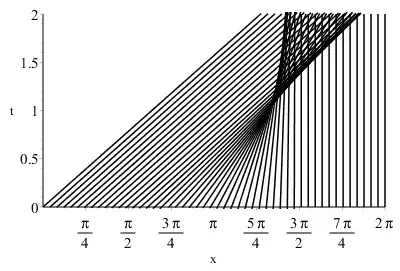This is a partial answer, hoping it will help :
FIRST PART : Solving $\quad u_t+uu_x=0\quad $without taking account of the initial conditions.
Set of characteristic differential equations : $\quad \frac{dt}{1}=\frac{dx}{u}=\frac{du}{0}$
A first equation of characteristic curve comes from $du=0\quad\to\quad u=c_1$
A second equation of characteristic curve comes from $\quad \frac{dt}{1}=\frac{dx}{c_1} \quad\to\quad x-c_1t=c_2$
General solution on the form of an implicit equation :
$$\Phi\left(c_1\:,\:c_2\right)=\Phi\left(u\:,\:x-ut\right)=0$$
where $\Phi$ is any differentiable function of two variables. An equivalent form is :
$$u=F\left(x-ut\right)$$
where $F$ is any differentiable function of one variable.
SECOND PART :
Particular solution with regard to the initial condition $\quad u(x,0)=\phi(x)$
$$u(x,0)=F(x+0u)=F(x)=\phi(x)$$
$$u(x,t)=\phi(x-ut)$$
The function $\phi$ is defined as :
$\quad \begin{cases}
\phi(\theta)=2\qquad\text{if } \quad \theta \leq \frac{\pi}{2}\\
\phi(\theta)=\sin(\theta)+1 \qquad\text{if }\quad \frac{\pi}{2}\leq \theta \leq \frac{3\pi}{2}\\
\phi(\theta)=0\qquad\text{if } \quad \frac{3\pi}{2}\leq\theta
\end{cases}$
We introduce a dummy variable $\theta$ in order to not confuse $x$ when $t=0$ with $(x-ut)$ when $t\neq 0$.
Thus the solution is :
$$\quad \begin{cases}
u=2\qquad\text{if } \quad (x-ut) \leq \frac{\pi}{2}\\
u=\sin(x-ut)+1 \qquad\text{if }\quad \frac{\pi}{2}\leq (x-ut) \leq \frac{3\pi}{2}\\
u=0\qquad\text{if } \quad \frac{3\pi}{2}\leq(x-ut)
\end{cases}$$
$$\quad \begin{cases}
u=2\qquad\text{if } \quad x \leq 2t+\frac{\pi}{2}\\
u=\sin(x-ut)+1 \qquad\text{if }\quad ut+\frac{\pi}{2}\leq x \leq ut+\frac{3\pi}{2}\\
u=0\qquad\text{if } \quad x \geq\frac{3\pi}{2}
\end{cases}$$
From this, it is possible to draw the curves $x(t)$ for various specified values of $u$.
Note that : $\quad 0\leq u\leq 2$
The figure below shows $u$ as a function of $x$ for various values of $t$ (Drawn from numerical calculus) :

$u=0$ for $t>\frac{2\pi}{3}$ and/or $x>\frac{2\pi}{3}$

